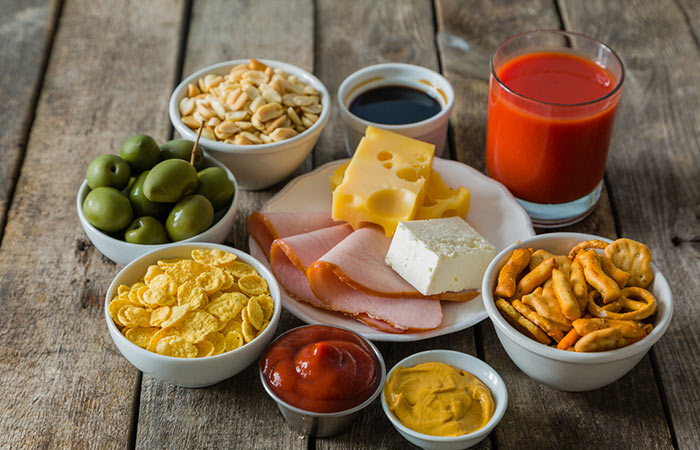
Even though salt plays a key role in human health, such as transporting water around the body, maintaining fluid levels and supporting muscle and nerve function. We just need a very tiny amount (less than 1 gram per day) to support human biological functions.
The current UK government recommendation on salt is to consume no more than 6 grams a day, which is equivalent to one single teaspoon of salt. Yet, research shows that adults living in England alone consume around 8.4 grams a day. Too much salt in the diet can contribute to long-term chronic conditions and diseases such as, but not limited to, hypertension, cardiovascular disease, stroke and kidney disease.
On an individual level, there are steps that we can take to become more salt aware. One way to reduce salt intake is to look out for the salt content in everyday foods and go for lower-salt options. Most food products display a ‘traffic light’ label‘ to show if the food has high, medium or low amounts salt (as well as fat & sugars)
In addition, we can look out for certain words on food packaging like below:
Smoked
Smoked meat, fish & poultry can be a good source of some nutrients like protein, B vitamins, iron and omega 3 fatty acids (oily fish). However, some smoked foods may be dipped or soaked in brine or rubbed with salt before smoking to add a further preservative mechanism to extend the shelf-life (Fellows, 2017).
What to consider:
- Marinade meat, fish or poultry with fresh herbs & spices prior to cooking.
- Have some meat-free days during the week to help you reduce processed meat intake.
- Soak smoked meat or fish in water overnight, changing the water every hour or so before cooking.
Brine
Brining is a common method of preserving & producing foods (e.g., cheese, meat, fish & olives). Foods preserved in brine are usually immerged in a solution of water & salt (sometimes vinegar & salt solution). The longer the brining time, the higher the salt content of a particular food.
What to consider:
- Try to go for canned fish like mackerel or sardines in olive oil/sunflower oil instead of brine.
- Opt for ‘reduced salt’ options when it comes to buying olives and cheeses.
- If you prefer brined foods, consider preparing them yourself (as you have control of how much salt is added). Remember, a little goes a long way!
Corned
Corned chicken & beef are made by brining in a salt and spice solution to flavour and tenderise it. Even though corned chicken & beef provides protein and nutrients like iron and vitamin B12, they are relatively high in salt.
What to consider:
- It’s a good idea to reduce the amount of corned chicken or beef you eat to just once in a while.
- Try to have at least 2-3 meat-free days each week.
- Swap canned meats for canned fish (in olive oil or sunflower oil) or, or have a vegetarian (plant-based) meal.
Pickled
Pickling is the process of preserving foods in an acid solution, usually vinegar, or in salt solution (brine). Usually, pickles refer to vegetable products, but sometimes, fish, eggs, or meat is also subjected to pickling.
What to consider:
- Consider making homemade pickled vegetables without salt.
- You can use fresh herbs & spices (e.g. garlic and ginger) for a delicious taste.
Salted
Salted foods obviously contain moderate amounts of salt. Think: salted nuts…sea salted popcorn…ready salted crisps…salted plantain chips…etc. A diet high in salt can cause raised blood pressure, which can increase risk of heart disease and stroke.
What to consider:
- Switch salty snacks for non-added salt alternatives.
- Consider buying unsalted snacks and flavouring with spices yourself: e.g. unsalted cashew nuts with paprika powder.
- Check out food labels for salt and go for lower salt or sodium choices.
Cured
Some chilled sliced meat products are cured and contain high amounts of salt.
In addition, smoking and added seasonings contribute to the flavour of different cured meat products. Some examples include: salami and chorizo slices.
What to consider:
- Use the traffic light labels on the front of packaging to help you make healthier choices.
- Compare salt levels among similar products and try to choose those lower in salt.
- Eat cured meats less often and in smaller amounts.
- Instead of cured meats for fillings in sandwiches, consider having chicken, fish, or vegetables like avocado or roasted peppers.
References:
- Action on salt (2022) Chilled Sliced Meats. Available at: http://www.actiononsalt.org.uk/salt-surveys/2022/chilled-sliced-meats (Accessed: 15 May 2023).
- Action on salt (n.d) Eating at home . Available at: http://www.actiononsalt.org.uk/less/reducing-intake/cooking (Accessed: 19th May 2023).
- British Dietetic Association (2020) Salt Food Fact Sheet. Available at: http://www.bda.uk.com/resource/salt (Accessed: 16 May 2023)
- Fellows, P. (2017) ‘Properties of food and principles of processing’, in Food Processing Technology . 4th edn.
- NHS (n.d) Red meat. Available at: http://www.nhs.uk/live-well/eat-well/food-guidelines-and-food-labels/red-meat-and-the-risk-of-bowel-cancer. (Accessed: 15th May 2023).
This post is for information purposes only and not intended to substitute tailored/personalised medical or dietary advice provided by your doctor or dietitian, respectively. If you require one-to-one dietary support, dietitian expert to provide educational session on reducing salt intake or help to identify ways to reduce salt content in meals, please do not hesitate to get in touch with me: info@taitalksnutrition.com
This is very helpful. Thank you
LikeLike
Thank you so much for reading :).
LikeLike
This is so helpful! Im trying to eat healthier foods and I will definitely be following your guide! 🙂
LikeLiked by 1 person
Thank you so much for reading, I am really glad that you found it useful 🙂
LikeLike
I enjoyed reading this – I am sharing this with family x
LikeLiked by 1 person